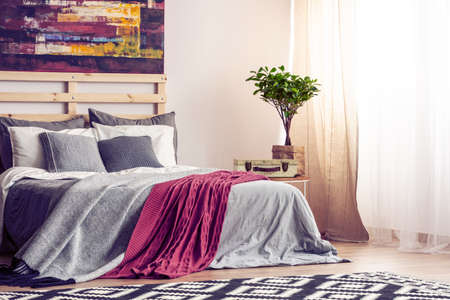Understanding the British Bedroom: Challenges and Opportunities
British homes, whether nestled in historic Victorian terraces or contemporary city flats, present unique bedroom layouts that influence how space is utilised. Many period properties feature compact rooms with alcoves, chimney breasts, and sash windows—charming architectural details that can also limit furniture placement. Modern flats, particularly in urban centres like London or Manchester, often prioritise open-plan living at the expense of generous bedroom proportions, resulting in multifunctional but sometimes cramped sleeping quarters. These distinctive spatial constraints mean that maximising every inch becomes a necessity rather than a luxury. Understanding these challenges allows homeowners to creatively reimagine their bedrooms not just as places to sleep, but as restorative sanctuaries. By recognising the opportunities hidden within quirky nooks or underused corners, British residents can create spaces that nurture both relaxation and wellbeing. Incorporating Feng Shui principles within this context provides a thoughtful framework for optimising both flow and function, transforming even the most modest bedroom into a haven tailored for restful sleep.
2. The Foundations of Feng Shui for Sleep
Feng Shui, an ancient Chinese practice, focuses on arranging living spaces to promote balance, positive energy flow (Qi), and overall harmony. For British homes—often characterised by unique architectural quirks and varying room sizes—adapting core Feng Shui principles can transform a bedroom into a restful sanctuary. Central to Feng Shui for sleep are three essential elements: restfulness, the smooth movement of energy, and harmonious surroundings.
Restfulness: Cultivating a Calm Environment
Creating a restful bedroom begins with minimising clutter and choosing soothing colours. In the UK, where bedrooms may double as study or storage spaces, it’s crucial to maintain simplicity. Neutral palettes such as gentle greys or muted greens echo British landscapes and support tranquillity.
Energy Flow: Positioning and Circulation
The placement of furniture—especially the bed—plays a pivotal role in ensuring Qi moves gently through the room. For optimal sleep:
| Feng Shui Principle | Practical Application in UK Homes |
|---|---|
| Commanding Position | Place the bed diagonally opposite the door without being directly in line; this invites security while maintaining awareness of the entry point. |
| Clear Pathways | Avoid blocking walkways with large wardrobes or bedside tables, especially in smaller British bedrooms. |
| No Mirrors Facing Bed | Mirrors reflecting the bed can disrupt rest; position them thoughtfully or use them on wardrobe doors facing away from sleeping areas. |
Harmony: Integrating Elements for Well-being
Balance is at the heart of Feng Shui. Incorporate soft textiles—like wool throws or linen curtains—to add warmth that resonates with Britain’s climate. Introduce natural elements such as potted lavender or wooden accents to ground the space and foster a sense of peace.
By weaving these foundational Feng Shui principles into the design of British bedrooms, residents can create environments primed for restorative sleep and enhanced well-being.
![]()
3. Clever Layout Ideas for British Spaces
When it comes to British homes, bedrooms are often charmingly compact yet full of character. Maximising every inch without compromising on comfort or style is essential for cultivating both restful sleep and good energy flow. By weaving together practical Feng Shui principles with clever space-saving strategies, you can craft a calming sanctuary even within the most modest of rooms.
Multi-Functional Furniture: A British Staple
Begin by opting for multi-purpose furnishings that reflect the British knack for ingenuity. Consider beds with built-in drawers or ottoman storage to tuck away bedding and seasonal clothing, keeping clutter at bay—a key tenet of Feng Shui. Slim-profile wardrobes or wall-mounted shelves provide vertical storage without overwhelming the room, while bedside tables with drawers offer a discreet home for essentials.
The Art of Bed Placement
Feng Shui encourages positioning your bed so you have a clear view of the door but are not directly in line with it—what’s known as the “command position.” In British bedrooms where space is tight, try placing the headboard against a solid wall, away from windows and radiators to maintain stability and warmth. This layout not only promotes a sense of security but also optimises floor space for easy movement.
Smart Zoning for Peaceful Sleep
If your bedroom doubles as a workspace—a common feature in many UK homes—use screens or bookcases to subtly define sleeping and working zones. Light, airy curtains or a folding partition can separate areas without blocking natural light, supporting both productivity and relaxation. Opt for soft, earthy tones inspired by the British countryside to enhance calmness and encourage restorative rest.
Letting Energy Flow Freely
Avoid overcrowding your bedroom with excess furniture. Allow at least 60cm of clearance around the bed to support free energy flow and effortless navigation—echoing both Feng Shui ideals and the practicality beloved in British interiors. Keep pathways unobstructed, particularly between the entrance and the bed, to welcome positive chi and foster a tranquil environment conducive to deep sleep.
4. Choosing Materials and Décor the British Way
When it comes to creating a restful bedroom that aligns with both Feng Shui principles and British design, the art lies in selecting colours, textiles, and artefacts that evoke harmony while celebrating local aesthetics. British homes are famed for their understated elegance and historical richness, which can be beautifully married with Feng Shui’s emphasis on balance and positive energy flow.
Colour Palettes: Subtle Sophistication Meets Calm Energy
British interiors often lean towards muted tones, drawing inspiration from the countryside—think sage greens, misty blues, and soft greys. These hues not only exude serenity but also resonate with Feng Shui’s recommended palette for restful sleep. Earthy neutrals and pastels promote a tranquil environment by reducing visual clutter and supporting relaxation.
| Feng Shui Element | Recommended Colour | British Design Example |
|---|---|---|
| Earth | Cream, Sand, Taupe | Cotswold stone shades |
| Wood | Sage Green, Olive | English heritage greens |
| Water | Pale Blue, Navy | Cornish coastal blues |
| Metal | Soft Grey, Pewter | Lakeland misty mornings |
| Fire (Accent) | Blush Pink, Burnt Orange (sparingly) | Regency-era trims and details |
Textiles: Comfort with Character
Selecting the right textiles is essential for both comfort and energy flow. In true British style, layer natural fibres such as cotton, linen, or wool for bedding and curtains. These materials allow breathability and warmth while enhancing tactile comfort. Opt for classic patterns like herringbone or subtle florals—these motifs offer visual interest without overwhelming the space or disrupting Chi (energy) circulation.
Bedding Tips:
- Avoid overly bright or synthetic fabrics that may agitate sleep.
- Pile cushions sparingly; keep arrangements symmetrical to maintain energetic balance.
- Plaid throws or knitted blankets bring in British cosiness while grounding the bed area per Feng Shui advice.
Artefacts: Curate with Meaning and Heritage
The British love for heirlooms and craftsmanship dovetails perfectly with Feng Shui’s appreciation of meaningful objects. Choose décor pieces that tell a story—perhaps a vintage clock, framed botanical prints, or handcrafted ceramics. Display personal mementoes thoughtfully but avoid overcrowding surfaces; each item should have space to ‘breathe’ so energy can circulate freely.
Dressing the Walls:
- Select calming artwork inspired by British landscapes or gentle abstracts.
- Avoid images of water directly above the bed, as per Feng Shui guidance.
- Use mirrors judiciously—never facing the bed—to reflect light without disturbing restfulness.
By weaving together timeless British materials and décor traditions with the mindful principles of Feng Shui, you can create a bedroom sanctuary that feels both rooted in local character and attuned to optimal wellbeing—a true reflection of balanced living in a modern UK home.
5. Light, Air, and Clutter: Optimising the Environment
Creating a harmonious bedroom in a British home requires careful consideration of light, air quality, and clutter control—each element directly influencing your sleep quality according to Feng Shui principles. In the UK, where natural daylight varies dramatically with the seasons, it’s essential to maximise every ray. Opt for layered window treatments such as sheer curtains paired with heavier drapes; this allows you to embrace gentle morning light during spring and summer, while offering cosiness and privacy through longer autumn and winter nights. Soft bedside lamps with warm-toned bulbs can introduce a gentle glow, avoiding harsh overhead lighting that disrupts the room’s tranquil energy.
Ventilation in the British Climate
Good airflow is vital for both health and positive energy flow. British homes, particularly older properties, often battle condensation and stuffiness due to tightly-sealed windows or traditional double glazing. Whenever possible, open windows daily—even just briefly—to refresh the air and disperse stagnant qi. Consider adding houseplants like English ivy or peace lilies; they not only purify indoor air but also bring vitality into your sanctuary. For colder months, a quiet air purifier can support healthy breathing without causing uncomfortable draughts.
Taming Clutter for Calm
Clutter is the enemy of restful sleep and balanced chi. In compact British bedrooms, clever storage solutions are invaluable. Utilise under-bed drawers, built-in wardrobes, and multi-functional furniture to keep surfaces clear and maintain visual calmness. Donate or recycle anything unused—Feng Shui teaches that letting go creates space for new opportunities. Keep bedside tables minimal: just a lamp, a book, and perhaps a cherished photo or plant will suffice. By nurturing an environment free from excess, you invite serenity and restorative rest.
Summary Tips
For optimal sleep in your British bedroom: maximise natural light during the day; layer lighting for evening comfort; ensure regular ventilation despite the climate; incorporate plants for freshness; and declutter ruthlessly. When these environmental elements harmonise, your bedroom becomes not just a place to sleep but a true retreat for wellbeing.
6. Integrating Personal Touches While Respecting Feng Shui
Celebrating British Heritage in Your Sleep Sanctuary
British homes are rich with tradition, often filled with heirlooms, vintage finds, and personal mementos that evoke comfort and nostalgia. When applying Feng Shui principles to your bedroom, it’s essential to strike a balance between these cherished items and the guidelines for optimal energy flow. Begin by thoughtfully curating what you display—prioritise objects that bring joy, positive memories, and tranquillity, such as a family photograph in a soft wooden frame or a hand-stitched quilt passed down through generations.
Choosing Meaningful Pieces with Intention
Feng Shui encourages mindful selection and placement of personal items. In British homes, this might mean displaying a favourite ceramic tea set on a small shelf or incorporating classic Liberty prints in your bedding. Position these items so they do not clutter surfaces or impede natural movement around the room. Remember, less is often more; allow each treasured piece to breathe and be appreciated without overwhelming the space.
Blending Tradition with Harmony
To maintain both cultural identity and restful energy, avoid placing sentimental objects directly facing the bed, particularly those linked to energetic events or emotional memories. Instead, opt for gentle accents—such as a well-loved novel on your bedside table or a vase of fresh garden flowers—that evoke warmth without disrupting calmness. If you wish to display artwork depicting British landscapes or heritage motifs, hang them at eye level where they create a sense of peace and grounding.
Respecting Flow While Adding Personality
Feng Shui values unobstructed pathways and an uncluttered environment. Use storage solutions like under-bed drawers or built-in wardrobes—classic features in many British homes—to keep personal belongings organised yet accessible. When introducing decorative elements, choose natural materials common in the UK, such as wool throws or oak furniture, which align beautifully with Feng Shui’s emphasis on nature and authenticity.
Creating Your Unique Restful Retreat
The key is thoughtful integration: let your bedroom reflect your story while embracing harmony. By blending beloved British traditions with Feng Shui guidance—focusing on intentional curation, strategic placement, and natural materials—you can create a restful retreat that is both deeply personal and energetically balanced.


